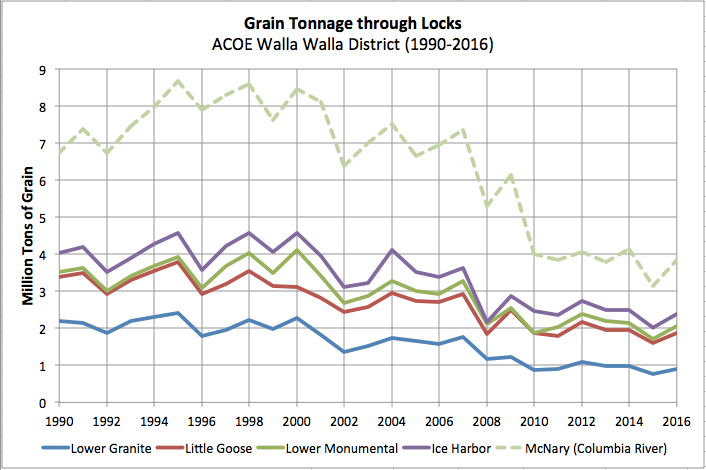forum
library
tutorial
contact

Tearing Down Snake River Dams
Remains Terrible Idea
by Editorial Board
Walla Walla Union-Bulletin, November 30, 2016
|
the film forum library tutorial contact |

|
Tearing Down Snake River Dams
by Editorial Board
|
A federal judge's ruling has revived the debate, but it
doesn't change the fact the move would be a disaster for this region.
 Tearing down the four Snake River dams would be a disaster for the Pacific Northwest. The water from a free-flowing Snake would flood farms, roadways, homes and even cities. But the action would not necessarily be a boon to salmon runs.
Tearing down the four Snake River dams would be a disaster for the Pacific Northwest. The water from a free-flowing Snake would flood farms, roadways, homes and even cities. But the action would not necessarily be a boon to salmon runs.
It is unrealistic to believe the hands of time can be turned back.
Yet, once again, a federal judge has stirred the waters when he rejected the most recent of five federal plans for restoring wild salmon and steelhead runs on the Columbia and Snake river systems.
U.S. District Court Judge Michael H. Simon ordered federal agencies to prepare a new plan by early 2018.
And, as a result, breaching the Lower Snake River dams is a hot topic of debate.
The court ruling doesn't specifically order the government to investigate breaching the four Lower Snake River dams to restore salmon, but Simon did say federal agencies had "done their utmost" to avoid considering breaching the Lower Snake dams. He went on to suggest a review analyzing the effect of breaching or bypassing one or more of the dams.
Why? In recent years, Snake River salmon have seen record-breaking and near-record-breaking runs due to efforts with hatchery fish, spilling more water over dams for juvenile fish and trucking salmon around dams. Yes, the 2015 heat wave took a toll on the fish, but that seems to be aberration of nature.
This matter has been studied and studied. A 2001 study by the U.S. Army Corps concluded breaching the Ice Harbor, Lower Monumental, Little Goose and Lower Granite dams would increase the chances of salmon restoration only slightly -- if at all -- while significantly hurting the Pacific Northwest's economy.
Taking down the dams would change the flow of the river, putting a lot of the region under water. It would force a significant change to irrigation systems, likely putting an end to many agricultural operations.
And crops and other goods could no longer be barged down the river, forcing the products to be hauled by trucks on the roadways. Boosting the truck traffic would be environmentally irresponsible.
About 3,700 farmers grow wheat and barley in the region, most of which is shipped to Portland to be exported overseas. A tug pushing a barge can haul a ton of wheat 576 miles on a single gallon of fuel.
The loss of hydropower would also be a blow to the environment as well as the economy. The water that flows through the turbines at the dams creates electricity that can't be produced as cleanly or cheaply any other way.
If we were today debating whether to build these dams, there would more information available and different considerations. But the dams are now in place.
In the end, when the latest study and public hearings are done, the conclusion should be the same as the previous efforts: The Lower Snake River dams must remain.
learn more on topics covered in the film
see the video
read the script
learn the songs
discussion forum
